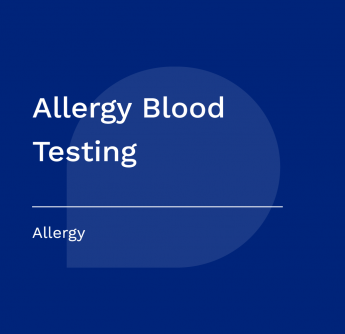Types of Allergy Tests
There are a number of ways to test for allergies, and your doctor will recommend what type of testing is best based on the symptoms you are experiencing. Here are some of the most common allergy tests:
More Allergy Tests
Getting Tested for Allergies
Allergy testing is almost always performed in a controlled medical setting like a doctor’s office or hospital. Allergen exposure can provoke serious reactions that may be unpredictable. As a result, skin tests and oral food challenges require careful protocols to limit severe reactions — and to quickly and effectively respond if they occur.
Blood testing does not involve allergen exposure and does not have the same risk of reaction. In most cases, a blood sample is taken from your arm with a needle in a medical office and then sent to a laboratory for analysis.
For both skin or blood testing, tests are normally ordered by a doctor based on your past symptoms, allowing the testing to focus on a specific allergen or set of allergens. It is important for anyone with concerns about allergies to talk to their doctor about tests that may be most beneficial in their situation.
Costs of allergy testing
The cost of an allergy test depends on how comprehensive the panel is, along with how and where the test is performed. Insurance can cover allergy testing that is performed in a doctor’s office, laboratory, or other professional health care setting. Talk to your doctor about the cost and payment options before testing.
Types of sample collection
The sample for an allergy test will depend on the particular test you’re taking. The most common ways for testing allergies are by a skin prick test, also referred to as a puncture or scratch test that is usually performed on the forearm or back. Blood testing can also test for allergies, and this requires a needle blood drawn from a vein, usually in the arm.
Getting test results
Allergy test results are usually reviewed with the doctor and in many cases with an allergist. Test results alone often aren’t enough to demonstrate an allergy. Instead, they are typically considered together with past allergic reactions.
Depending on the test results and your history, your doctor might recommend more than one test to confirm or rule out an allergy.
Sources
A.D.A.M. Medical Encyclopedia. Allergies. Updated February 2, 2020. Accessed October 3, 2022. https://medlineplus.gov/ency/article/000812.htm
Brod BA. Patch testing. In: Fowler JA, ed. UpToDate. Updated July 28, 2020. Accessed October 3, 2022. https://www.uptodate.com/contents/patch-testing
Burks W. Diagnostic Evaluation of Food Allergy. In: Sicherer SH, ed. Updated April 23, 2019. Accessed October 3, 2022. https://www.uptodate.com/contents/diagnostic-evaluation-of-food-allergy
Burks W. Patient Education: Food Allergy Symptoms and Diagnosis (Beyond the Basics). In: Sicherer SH, ed. Updated January 22, 2021. Accessed October 3, 2022. https://www.uptodate.com/contents/food-allergy-symptoms-and-diagnosis-beyond-the-basics
Commins SH. Food Intolerance and Food Allergy in Adults: An Overview. In: Sicherer SH, ed. Updated May 28, 2020. Accessed October 3, 2022. https://www.uptodate.com/contents/food-intolerance-and-food-allergy-in-adults-an-overview?
Kowal K, DuBuske L. Overview of Skin Testing for Allergic Disease. In: Bochner BS, Wood RA, eds. Updated April 3, 2020. Accessed October 3, 2022. https://www.uptodate.com/contents/overview-of-skin-testing-for-allergic-disease
Kowal K, DuBuske L. Overview of In Vitro Allergy Tests. In: Bochner BS, ed. Updated February 5, 2021. Accessed October 3, 2022. https://www.uptodate.com/contents/overview-of-in-vitro-allergy-tests
MedlinePlus: National Library of Medicine. Allergy. Updated May 16, 2018. Accessed October 3, 2022. https://medlineplus.gov/allergy.html
MedlinePlus: National Library of Medicine. Food Allergy Testing. Updated July 31, 2020. Accessed October 3, 2022. https://medlineplus.gov/lab-tests/food-allergy-testing/
National Academies of Sciences, Engineering, and Medicine. Finding a Path to Safety in Food Allergy: Assessment of the Global Burden, Causes, Prevention, Management, and Public Policy. The National Academies Press; 2017. Accessed October 3, 2022. https://www.nap.edu/catalog/23658/finding-a-path-to-safety-in-food-allergy-assessment-of
Pawankar R, Holgate ST, Canonica W, Lockey RF, Blaiss MS, eds. White Book on Allergy 2013 Update. World Allergy Organization; 2013. Accessed October 3, 2022. https://www.worldallergy.org/UserFiles/file/WhiteBook2-2013-v8.pdf
Sicherer SH. Oral Food Challenges for Diagnosis and Management of Food Allergies. In: Wood RA, ed. Accessed October 3, 2022. https://www.uptodate.com/contents/oral-food-challenges-for-diagnosis-and-management-of-food-allergies




